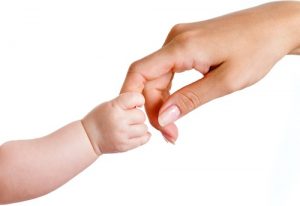
Attachment is used a lot in parenting magazines and often comes up in discussions among parents. You might hear another parent say “we are practicing attachment parenting” or “my baby is very attached to me.”
However, the word “attachment” in the world of child psychology has a very specific meaning, compared to the popular use of the word in terms of parenting techniques. In fact, a whole line of research has developed focused solely on attachment theory.
The topic of attachment is a perfect example of how our Western culture often deals with parenting issues. Instead of a theoretical concept, it took hold as a form of parenting with rules and techniques, which have ultimately led to debate and divisions.
Early attachment research
The academic understanding of attachment was developed primarily by two psychologists – John Bowlby and Mary Ainsworth. Bowlby became interested in parent-child attachments in post-World War II Europe after he saw the distress and psychological damage caused by children being separated from their parents due to war and disease. At that time, parents were often not allowed to see their hospitalised children, sometimes for months on end. He began to theorise that infants and children were evolutionarily wired to seek proximity to an attachment figure (usually a parent) due to the need for safety, security and care. Infants and young children use “attachment behaviors” such as crying, clinging and following to try to meet this need to be close to their attachment figure. He also theorised that children who experience insensitive or unresponsive reactions from parents will be much more likely to have psychological problems later in life. This understanding of attachment became the basis of much of the psychological study of child development at the time, and continues to inform psychology programs today.
Mary Ainsworth, a student of Bowlby’s, further refined attachment theory. She argued that the interaction between the parent and child is key to determining what type of attachment is formed. If the parent is responsive to the child’s need for security and safety, the child learns that the parent can be relied upon. In contrast, if the child’s needs are met with unresponsiveness from the parent, the child learns that the parent cannot be relied upon and the child may develop means of coping with this such as becoming overly clingy or avoiding the parent.
Another interesting aspect of attachment theory is the idea that children develop an “internal working model” of how relationships function based on their attachment with their parent. In other words, if a child feels their parent can be trusted to meet their needs, they (unconsciously) feel that other adults (i.e. teachers, friends) are also trustworthy. Similarly, children also develop internal working models of themselves. If their parent is responsive to them, they come to understand that they themselves are worthy of care.
Ainsworth went on to intensely observe mothers and infants in their homes in Uganda, several hours a day for up to nine months. Upon returning to the U.S., she continued a similar type of study in Baltimore with a sample of American mothers and infants. Ultimately she devised a study method called the Strange Situation which enabled researchers to determine what kind of attachment an infant had with his/her parent.
Basically, the Strange Situation involves a series of short separations and reunions between the infant (usually around 12 months old) and his/her parent or primarily caregiver (usually the mother). How the child responds to the parent when she returns is key to understanding the attachment style. Ainsworth ultimately developed four attachment categories based on the Strange Situation:
Secure: Most children (about 60%) play happily when in the same room with their mother. They typically spend some time close to their mother and some time exploring their surroundings. They use their mother as a “secure base” from which to explore their new environment. Upon separation these children are typically somewhat distressed but are easily calmed and comforted by their mother when she returns.
Ambivalent: Some children try to stay close to her even before the separation. When separated these children are extremely upset. Upon reunion with their mother, they seem to react with some ambivalence – they may cry to be picked up but then seem to push the mother away or not be easily soothed.
Avoidant: Some children show a pattern of avoidance with their mother. They do not engage in play with their mother while she is in the room and when she leaves they show little distress. Upon reunion with their mother, these children do not try to readily seek her out.
Disorganised: This category was developed several years later. These children are often very distressed by separations from their mothers but display disorganised behavior upon her return such as approaching but then backing away. They may show behaviors like frozen expressions or rocking. Most often these patterns are seen among children whose mothers have mental health problems or have experienced extreme trauma.
It is important to note that most children exhibit a secure attachment with their caregiver. Research has shown that children who show signs of insecure attachment (i.e. avoidant, ambivalent, etc.) most often have parents who were unresponsive or inconsistent in their responses to the child (i.e. sometimes responsive but not always) so he/she doesn’t know how to react.
Attachment parenting as distinct
Somewhere along the way, the term “attachment parenting” became a buzzword in parenting circles. While some of the ideas overlap, it is important to understand that attachment theory is different from attachment parenting. In developing attachment theory, psychologists Bowlby and Ainsworth did not set out any specific parenting techniques per se. Ainsworth wrote that the main factors that influence attachment are: sensitivity-insensitivity, acceptance-rejection, cooperation-interference, and accessibility-ignoring. How these ideas play out in the everyday life of parenting can vary quite a bit.
While based in research, the notion of attachment took hold in our collective psyche as a model of parenting all of its own. Proponents of attachment parenting will often encourage practices such natural birth, co-sleeping and babywearing.
As a new mother, my understanding of “attachment” was a set of rules and techniques. When my first son was an infant I attended a new mom support group and I was overwhelmed by the rules and ideas of attachment parenting that were floating around in the conversations. Most of the women in the group had adopted the “rules” of attachment parenting wholeheartedly. Many of them co-slept with their babies, wore their babies in carriers almost all day, and never left their child with babysitters. As a stressed, new mom with a tiny newborn I honestly felt overwhelmed by the idea of all of these “rules.” At the time I did co-sleep with my child, but mostly because it was the only way he would sleep for more than 20 minutes at a time. As soon as he could sleep for a few hours at a time, he was moved to the bassinet. I did wear him in a carrier much of the time but simply because it was the only way he wouldn’t cry. As soon as he became mobile enough to squirm out of my arms, he would hardly have anything to do with being held much – he was on the move.
Attachment in all its varied beauty
Fast forward seven years and that newborn is now a boisterous second-grader. Looking back, on the ideas of “attachment” I realise that the research that Ainsworth did all those years ago really does matter in daily life. “Attachment” in its truest, theoretical sense is really just the dynamic, beautiful relationship that develops between caregiver and child over the course of the first few years of life. Some (not all) proponents of attachment parenting might have you believe that if you do not wear your baby 15 hours a day that you will not form a secure attachment with him/her. Any parent with a little experience knows this is not true. Attachment in its most lovely form is about the interplay between what your child needs, what you need, and finding a balance of both. Being in sync with your child does not mean following a set of arbitrary rules, it means meeting your child where they are at and changing when their development takes them down a different path.













